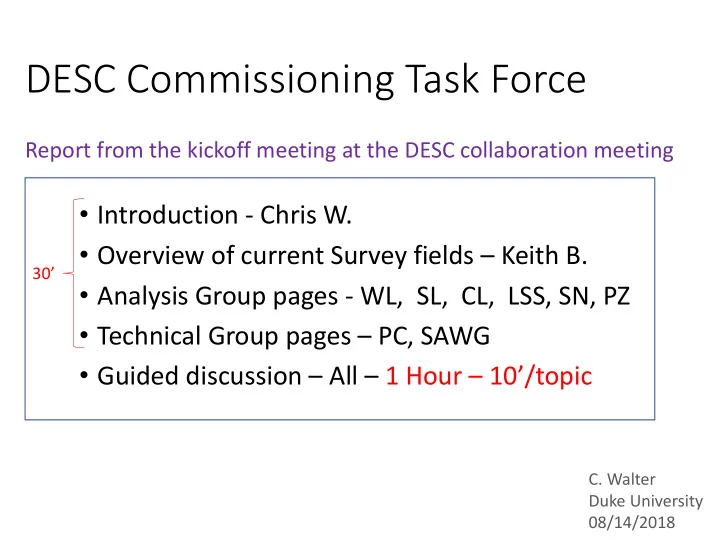

DESC Commissioning Task Force Report from the kickoff meeting at the DESC collaboration meeting • Introduction - Chris W. • Overview of current Survey fields – Keith B. 30’ • Analysis Group pages - WL, SL, CL, LSS, SN, PZ • Technical Group pages – PC, SAWG • Guided discussion – All – 1 Hour – 10’/topic C. Walter Duke University 08/14/2018
Introduction Both before and during the commissioning there are places that the DESC and its members can likely support the commissioning effort. Additionally, the DESC may benefit from commissioning, both through joint development of tools and through possible data products that are produced during commissioning. We kick-started this effort at the meeting by gauging interest and talking through various strategies.
Topics we discussed 1. Input for the on-sky observation periods. 2. Focused simulation requests. 3. Tools. 4. DESC contribution to current hardware and commissioning efforts. 5. DESC contributions during commissioning ‘Validation’ and ‘Preview’ periods. 6. Other Science Collaboration Contributions. 7. Next Steps.
Giving Input on Commissioning Fields Example: LPM-17 Pg. 26 - Photometric Repeatability Will need to look in a variety of environments. We need a menu of fields for this (and other requirements)
Photometric Repeatability: What should you consider for suggestions? • This work will be done with both the commissioning and full cameras. The project needs to be flexible and have several possible fields to observe. • For this requirement we need lots of stars in various environments. • Where are good fields to look at and what other interesting object that might be in the images? • Overlapped galaxies for blending? • Is there a galaxy cluster there? • Function of stellar density? • Challenging fields! – bright stars, bright galaxies, high densities • Known variable sources from catalogs • Etc., etc.
Input on Verification / Validation / Characterization From Andy C. leading alert production commissioning • Verification (testing we meet requirements): there are a couple of requirements (e.g. showing how well the spuriousness metric works for removing junk) that it would be good to get some thoughts from the WGs on on how how best to evaluate them • Validation (testing we can do the science): We have a growing list of metrics (e.g. deblending) already, but I'd like to have an additional small set of tests that the WG think are critical to show they can do their science. …. • Characterization (measuring performance): Specifying observations and conditions (e.g. particular fields on the sky that have previous observations) that particular metrics need to be tested over to characterize the performance of the system (e.g. testing the deblending metric by choosing a number of dense fields)
Example Input from the WGs My Summary: • WL: Fields that overlap with deep multiband surveys. • LSS: Photo-z fields with deep spectroscopy • CL: Observations of cluster fields, primarily those with HST mosaic data, both low and high z. Test shear, photometry, deblending. Prioritize clusters with lots of spectroscopy • SN: Overlap with deep spectroscopy to test photo-zs • PZ: Overlap with HST imaging to test blending effects, existing deep multiband photometry • SAWG: We (SAWG and the Project) wish to measure brighter-fatter directly on the sky, which we would efficiently perform from observations of dense stellar fields. • PC: Uniformity of focal plane response - dithered observations of stellar field under photometric conditions, Will probably need exposures of various lengths for bright standards/test non-linearity See examples next pages:
Selected Guided Discussion Questions
Input for on sky observations Although the project can’t guarantee the they will undertake specific observations, it will definitely consider advice from DESC and other science collaborations for candidate fields, cadences and dither patterns etc. There are a set of goals and criteria which will test project requirements associated with each field. There is already a list of candidate fields for each of these criteria but they aren’t yet finalized. As schedules may shift, and the time of year may vary, what is needed is a “menu” of appropriate options that can be selected for each field. Q: What process or input could DESC have to help with this? A: Project prefers informal input. We will write a DESC note where we layout our requests for fields and metrics which we will send to the project. It will include notebooks to implement needed tests.
Other Science Collaboration Contributions Q: Should the scope of this effort be broader than just DESC? A: We will work within the DESC to create our note. At the same time, through the spokesperson, we will let the other science collaborations know what we are doing and let them see our work and understand our timeline. We may try to coordinate prioritization.
Next Steps / Plan Q: What should the next steps be? A: CWW will start work on outline for our note, setup some communications and work on a way for us to share proposed fields among the WGs. KB will collect more info on project plans.
What do we need to start? • We need to create either templates or guidelines to give to the DESC WGs. Each WG will propose fields, tests and associated test codes. • What format should this be in? What must they include? Can we make a text template?
Conclusion / Next steps • DESC is interested contributing to suggested fields and validation tests. • We have representatives from each group for a commissioning task force and we are ready to begin. • We need guidance on making sure we provide the information needed.
Backup Slides WG input slides
1st Page
Recommend
More recommend